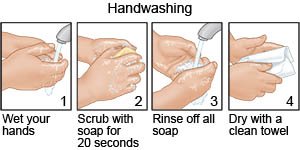Peg (Percutaneous Endoscopic Gastrostomy) Tube Insertion
Medically reviewed by Drugs.com. Last updated on Apr 6, 2025.
PEG insertion is a procedure to place a soft, plastic feeding tube into your stomach. You may get nutrition or medicine through the tube.
DISCHARGE INSTRUCTIONS:
Call your local emergency number (911 in the US) if:
- You have sudden trouble breathing.
Seek care immediately if:
- You have severe abdominal pain.
- Your feeding tube comes out.
- You have diarrhea leaking around your tube.
- Your abdomen becomes tight, hard, sore, or swollen.
Call your doctor or gastroenterologist if:
- You have abdominal pain or cramping.
- Your bowel movements look like the liquid food you use.
- You have a fever.
- The skin around your tube is red, warm, and swollen.
- Your tube is clogged or damaged.
- You have nausea or are vomiting, or you cannot have a bowel movement.
- You have questions or concerns about your condition or care.
Medicines:
You may need the following:
- Medicines can help decrease how much acid your stomach makes.
- Take your medicine as directed. Contact your healthcare provider if you think your medicine is not helping or if you have side effects. Tell your provider if you are allergic to any medicine. Keep a list of the medicines, vitamins, and herbs you take. Include the amounts, and when and why you take them. Bring the list or the pill bottles to follow-up visits. Carry your medicine list with you in case of an emergency.
Self-care:
- Change the bandage as directed. The PEG tube site may take up to 4 weeks to heal. While the site heals, turn the PEG tube to prevent tissue from growing over it.
- Prevent an infection. Always wash your hands before you care for the area around your PEG tube. Use soap and water. Dry your hands with a clean towel or a paper towel. Anyone caring for your PEG tube should wash his or her hands first.

- Arrange your feeding schedule. Time your feedings to make sure you get enough sleep. Tell your healthcare provider if the PEG tube makes it hard for you to sleep.
- Carry pads or absorbent cloths with you in case your PEG tube leaks. You may also want to bring a change of clothing.
Follow up with your doctor or gastroenterologist as directed:
Write down your questions so you remember to ask them during your visits.
© Copyright Merative 2025 Information is for End User's use only and may not be sold, redistributed or otherwise used for commercial purposes.
The above information is an educational aid only. It is not intended as medical advice for individual conditions or treatments. Talk to your doctor, nurse or pharmacist before following any medical regimen to see if it is safe and effective for you.
Further information
Always consult your healthcare provider to ensure the information displayed on this page applies to your personal circumstances.
